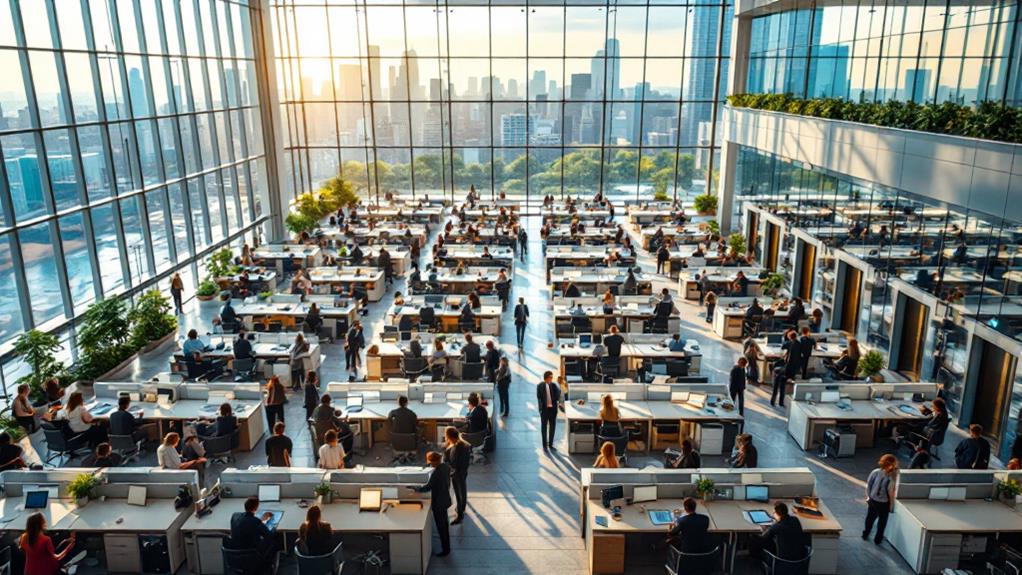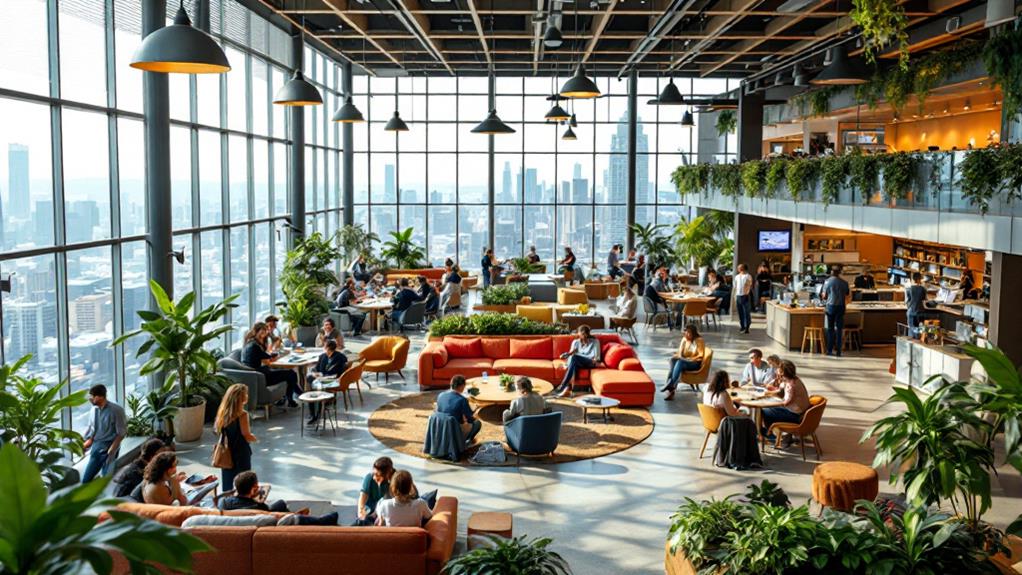What It’s Like to Work in the Largest Office Buildings

Working in the largest office buildings is an exciting blend of tradition and modernity. You experience directly the impact of groundbreaking architecture, like open spaces and iconic design features that encourage collaboration and creativity. Advanced technologies, such as virtual reality and smart office tools, improve your productivity and connectivity. Social dynamics are lively, with spaces designed to strengthen team bonds and emotional connections. The history and character of these buildings, like the SC Johnson Building, add depth to your workday, fostering a unique sense of belonging. There's much more to uncover about how these elements shape your experience.
Historical Influence of Architecture
The historical influence of architecture on office buildings is undeniable, with essential designs like the SC Johnson Building setting a new standard. Imagine stepping into a workspace where the architecture itself inspires creativity and collaboration. Frank Lloyd Wright's 1939 design was groundbreaking, focusing on the emotional connection between employees and their environment. This building wasn't just about walls and windows; it was about creating a lively atmosphere that felt almost cathedral-like.
You'll notice how natural light floods the space, a key element in Wright's vision. This use of light improves not only the aesthetics but also your mood and productivity. Architectural advancements, such as the unique dendriform columns, create an interplay of compression and expansion, stimulating a sense of openness and possibility. These design elements aren't just visually striking; they make you feel connected to the space, improving your work experience.
The SC Johnson Building also incorporated inventive built-in furniture and specialized lighting, ensuring functionality didn't take a backseat to form. This blend of practicality and beauty underscored its influence on modern office designs. As you work, you're part of a legacy that values both functionality and the emotional well-being of its occupants.
Iconic Design Features
Stepping into the SC Johnson Building, you'll immediately notice its iconic design features that blend creativity with aesthetic appeal. Frank Lloyd Wright's ingenious dendriform columns, which expand into petals 18.5 feet wide, combine structural strength with a look that's undeniably striking. These columns aren't just there to look pretty; they transform the building into a modern cathedral, providing both inspiration and an extraordinary backdrop for your workday.
As you move through the Great Workroom, you'll feel the natural light coming in from above, creating an open, airy atmosphere that fosters creativity and collaboration. Wright's use of Pyrex tubing for light fixtures further amplifies this effect, even if these features had their flaws. The room's built-in furniture seamlessly integrates form and function, though Wright's original three-legged chairs had stability issues, a reflection of the challenges of avant-garde design.
Despite the absence of modern air conditioning, the building's design cleverly manages ventilation, ensuring a comfortable environment. Wright's architectural philosophy shines here, emphasizing harmony between the physical space and the human experience, making every corner of the SC Johnson Building a demonstration of cutting-edge design.
Unique Employee Experiences

Amidst the architectural marvel that is the SC Johnson Building, employees often find themselves forming deep emotional connections to their workspace. The Great Workroom, with its soaring ceilings and cutting-edge design, becomes more than just an office. It's a place where creative collaboration thrives, inspired by the space's grandeur. You might feel like you're working in a cathedral, surrounded by Frank Lloyd Wright's original furniture, including the iconic three-legged chairs. These chairs, while aesthetically striking, present stability challenges, becoming part of the building's unique character and your shared experiences.
Personal anecdotes from employees reveal a space that's as inspiring as it is flawed. Despite occasional leaks and the rare mishap of falling glass from the Pyrex tubing, the building's historical significance remains undiminished. You often hear stories of past colleagues who've forged strong social connections here, weaving a rich tapestry of interactions that you're now a part of. The ongoing tours of the building offer glimpses into these experiences, underscoring the emotional bonds formed amidst its walls. Indeed, working in this creative haven is as much about the people as it is about the place itself.
Technological Work Environment
While the SC Johnson Building evokes a deep emotional connection through its architectural wonder, today's work environment also heavily relies on technological advancements to improve productivity and collaboration. In large office buildings, remote collaboration tools have become crucial, allowing you to connect with colleagues across the globe without leaving your desk. Video conferencing and cloud-based platforms shift the focus from physical presence to digital interaction, making it easier to work with teams spread out over multiple locations.
Smart office technologies are transforming these expansive spaces. IoT devices and automated systems improve comfort and efficiency, guaranteeing that lighting, temperature, and even desk allocation are optimized for your needs. This technological integration creates a seamless environment where you can focus on what truly matters.
Moreover, engaging training environments using virtual reality (VR) and augmented reality (AR) are redefining how you experience meetings and training sessions. These technologies offer captivating, interactive opportunities that traditional methods simply can't match. Furthermore, data analytics tools monitor performance and workspace utilization, providing insights to refine your work environment further. This data-driven approach guarantees that every aspect of your office experience is tailored to optimize productivity and satisfaction.
Social Dynamics in Offices

Social dynamics in large office buildings like the SC Johnson Building are intricately designed to improve collaboration and interaction among employees. The open spaces and communal work areas create a collaborative culture where ideas flow freely. You'll find that the Great Workroom, with its iconic dendriform columns, inspires creativity and fosters social connections. These architectural features aren't just about aesthetics; they're crucial in cultivating an environment where emotional engagement thrives.
As you navigate these expansive office landscapes, you'll notice that workplace relationships are bolstered by the historical significance embedded in the corporate campus. This emotional connection to the workspace elevates team dynamics, making daily interactions more meaningful. Employees often share nostalgic anecdotes about their shared workspaces, highlighting how these collaborative environments contribute to job satisfaction and strong social interactions.
However, the rise of remote work questions traditional notions of presence in fostering workplace relationships. The evolution of modern workspaces, driven by technology, challenges how we perceive these dynamics. Yet, even with these changes, the essence of a collaborative culture remains essential. It's about finding ways to maintain these connections, regardless of a physical or virtual setting, ensuring that emotional engagement continues to drive workplace success.
Balancing Tradition and Innovation
Balancing tradition and innovation is at the heart of the SC Johnson Building's enduring allure. Designed by Frank Lloyd Wright in 1939, this architectural marvel seamlessly marries cultural significance with design evolution. As you walk through its halls, you're immediately struck by the Great Workroom's dendriform columns that evoke a sense of compression and expansion. These unique structures not only support the building but also foster an environment ripe for creativity and collaboration.
Wright's vision extended beyond the mere structure; his incorporation of built-in furniture and custom designs has influenced modern corporate campuses. This approach guarantees that functionality complements aesthetic appeal, providing a workspace that adapts to changing times and technologies. Despite the rise of remote work, the SC Johnson Building retains its relevance, proving that traditional office environments still hold value.
The evolution of workspaces at SC Johnson reflects a broader shift in how we view the office. While technology enables more flexible work arrangements, the building's design maintains the essence of social connections. You see this balance in how SC Johnson inspires its employees, blending tradition with modern innovation to create a truly unique workplace experience.
Architectural Challenges and Solutions

The SC Johnson Building's architectural design presents several unique challenges, but solutions have been ingeniously crafted to maintain its iconic status. You might find the dendriform columns fascinating—they're not just artistic but also essential to the building's structural integrity. These columns, with their 18.5-foot petal and 9-inch base, create a dynamic sense of compression and expansion, tested with 60 tons of rocks to verify their strength.
However, maintaining this aesthetic functionality hasn't been without hurdles. For instance, the original Pyrex tubing led to leaks and falling glass, which needed addressing to protect both the design and occupants. Frank Lloyd Wright's vision for built-in furniture fostered collaboration, yet his three-legged chairs showed the struggle between aesthetic appeal and practical use. Their stability issues highlighted the delicate balance required to achieve design durability in a large office building.
Moreover, light plays a significant role in this workspace. The interplay of natural and artificial lighting improves the environment, making it more inviting and efficient. Each challenge has been met with creative solutions, guaranteeing the SC Johnson Building remains a masterpiece of architectural brilliance.
Legacy of Inspiring Workspaces
Building on the architectural challenges and solutions, the SC Johnson Building's legacy as an inspiring workspace emerges vividly. Designed by Frank Lloyd Wright in 1939, it set a standard for creative collaboration and workspace aesthetics. As you walk through the Great Workroom, the groundbreaking dendriform columns create a dynamic sense of compression and expansion, sparking creativity among employees. Wright envisioned workspaces as inspiring as cathedrals, incorporating built-in furniture and custom designs that improve both the atmosphere and your comprehensive experience.
The SC Johnson Building doesn't just focus on aesthetics; it prioritizes employee well-being too. Its unique design fosters emotional connections and a sense of belonging, making it more than just a place to work. Employees often share anecdotes about how the building's collaborative environment elevates workplace value and creativity.
This architectural marvel also influenced modern corporate campuses, inspiring designs adopted by companies like Google and Amazon. Public interest and tours of the building continue to highlight its enduring legacy. It balances traditional office values with the demands of today's technological work landscape, making it a timeless model for inspiring and functional workspaces.



